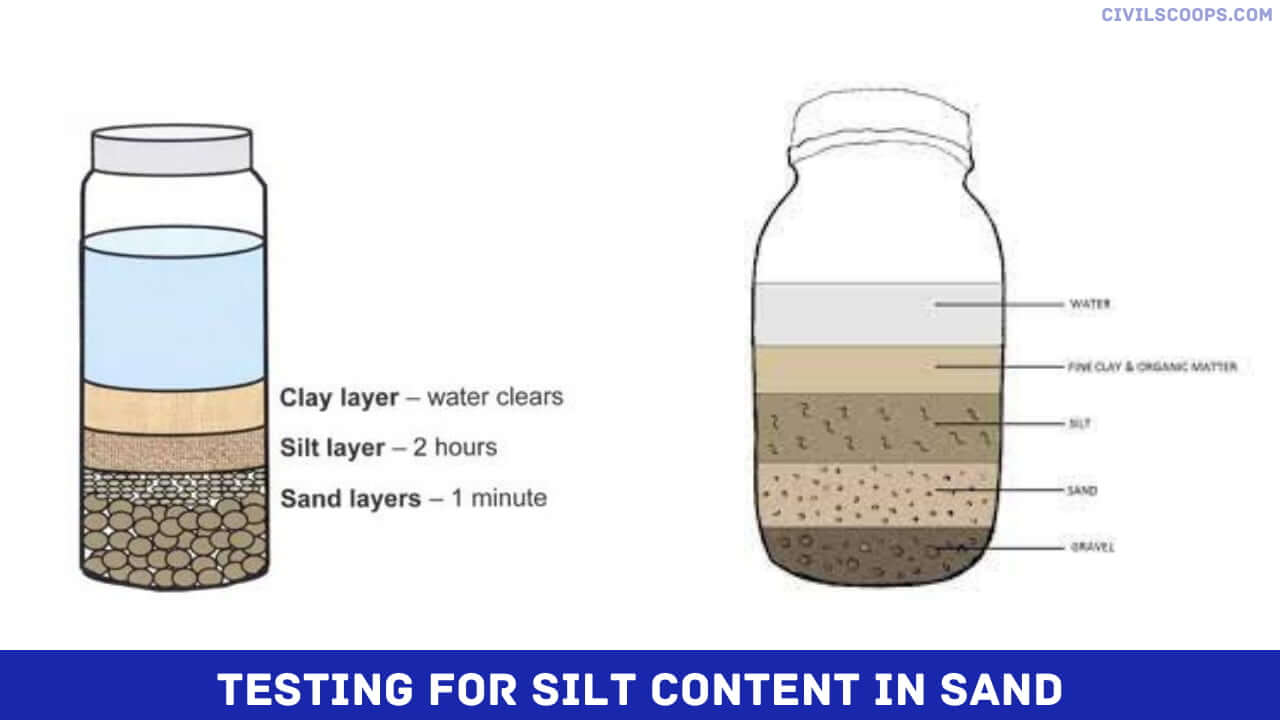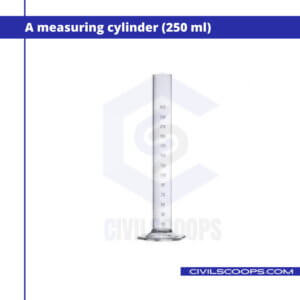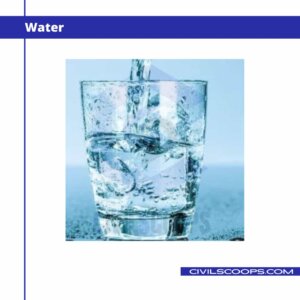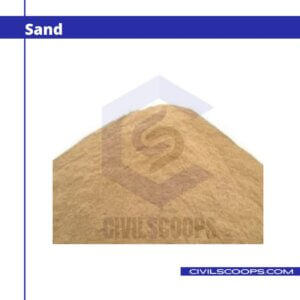Testing for Silt Content in Sand

Table of Contents
Why We Measure the Silt Content from the Sand?
Silt content is a fine material that’s less than 150 microns. It’s unstable in the presence of water. It’s unstable in the presence of water. If we utilize silty sand for bonding, it will reduce the strength and cause rework.
You could be experienced this while plastering for a roof where the mason tries to plaster the mortar where it gets continually peel off. The excessive quantity of silt, not only reduces the bonding of fine and concrete aggregates but also affects the strength and durability of work.
You may check out this article for silt and clay properties. In the field, we have to conduct a silt test for every 20 Cum of sand. This may vary.
Testing for silt content in Sand
Fine aggregate or Sand is one of the most important construction materials on any construction site. It should be selected very carefully as it contributes to the strength of various important mixtures such as concrete, ointments, and mortars.
Sand ought to be tested for the presence of soil, silt, moisture, and other harmful materials (salts, coal, mica) that can affect the strength of a structure and cause avoidable reorientation. Fine quality construction and has a particle size ranging from about 150 μm to 4.75 mm. This causes smaller particles to be classified as silt.
The presence of high salt content (> 8%) in the Sand Sand reduces the bonding capacity of the raw material and affects the strength and durability of the work. Silt content testing is recommended for every 20 m3 of Sand Sand.
Induction of Silt Content
The sand caused to a building site or other works may contain an amount of moisture, which will cause it, when loosely filled to a container, to occupy a large volume than it would occupy if dry.
If the sand is measured by loose volume, it’s necessary in such a case to increase the measured volume of the sand, so that the amount of sand put to the concrete might be the amount intended for the nominal mix used (based on dry sand).
It’ll be necessary to increase the volume of sand from the ‘percentage’ bulking. The correction to be made is only a rough approximation since the system of measurement by loose volume is a rough method at best.
However, the correction of the right order can easily be determined and must be applied in order to keep the concrete uniform.
Apparatus for Silt Content in Sand
- A measuring cylinder (250 ml)

- Water

- Sand

Test Procedure of Silt Content in Sand
- First, a 50 ml solution of 1% salt and water is prepared in the measuring cylinder. The addition of salt increases the silt disposal time.
- The sample of Sand Sand to be tested is then added to the cylinder until the level reaches 100 ml.
- 50 mL of salt and water solution is again added to the measuring cylinder.
- Close the open end of the measuring cylinder and shake it well.
- After a period of 3-4 hours, you will see a layer of silt settled on the Sand Sand.
- Now pay attention to the volume V1 of the silt layer settled on the Sand Sand.
- Note the volume V2 of the settled Sand Sand.
- Repeat the process a few times to get the average.
Percentage of Silt Content = (V1/V2) x 100
V1 – Volume of the silt layer
V2 – Volume of the sand layer
For example, for a given sand sample, if V1 comes out to be 9 and V2 is 130, the % silt content would be 6.9 %.
The permissible value of silt content in Sand is 8%. Hence the sand sample is ok and can be used for construction purposes.
Observation Table For Silt Content in Sand
[su_table responsive=”yes” alternate=”no”]
| Sr.no | Description | Sample 1 | Sample 2 | Sample 3 |
| 1 | Volume of silt layer (V1) | |||
| 2 | Volume of sample Sand (V2) | |||
| 3 | Percentage of silt | |||
| Average |
[/su_table]
Silt content test Procedure PDF : Click Here
[su_box title=”FAQ” style=”default” box_color=”#333333″ title_color=”#FFFFFF” radius=”3″ class=”” id=””]
Silt Content in Sand
The permissible value of silt content in Sand is 8%, hence the sand sample is ok and can be used for construction purposes.
Effect of Silt Content in Sand
From above results it is observed that sand from pampore with silt content 4.80 %, compressive strength, split tensile strength, and flexural strength is increased as days of curing increased.
What Is Silt Content?
Silt content means the mass of an aggregate sample smaller than seventy-five (75) microns in diameter as determined by dry sieving.
How to Find Silt?
Like other blocks that possess gravity, Silt can be easily harvested by digging below the block that is holding the Silt up then placing a Torch or Minecart Track under it. Then the last step is to break the supporting block & let the Silt fall in.
Sieve Analysis of Sand
Sieve Analysis Test of Sand is done to check the gradation of sand particles. Sand particle distribution in sand volume is important for good quality concrete and mortar. In this test, the sand sample is passed through a series of IS sieve sizes ordered from bigger to smaller sizes at the bottom.
Sieve Size for Sand
List of different types sieve size for sand are as follows.
- Sand: Material passing a 4.75-mm sieve (No. 4) and retained on a 0.075-mm (No. 200) sieve.
- Coarse Sand: Material passing a 4.75-mm sieve (No. 4) and retained on a 2.00-mm (No. 10) sieve.
- Medium Sand: Material passing a 2.00-mm sieve (No. 10) and retained on a 0.475-mm (No. 40) sieve.
- Fine Sand: Material passing a 0.475-mm (No. 40) sieve and retained on a 0.075-mm (No. 200) sieve.
- Clay: Material passing a 0.075-mm (No. 200) that exhibits plasticity, and strength when dry (PI ≥ 4).
- Silt: Material passing a 0.075-mm (No. 200) that is non-plastic, and has little strength when dry (PI < 4).
Importance of Bulking of Sand
It is useful for reducing the pores in the sand and compacting the sand resulting in the increase in volume. It helps for maintaining workability and placing of concrete. Helps in reduction of segregation by filling the pores between cement and aggregates.
[/su_box]
[su_note note_color=”#F2F2F2 ” text_color=”#333333″ radius=”3″ class=”” id=””]
Like this post? Share it with your friends!
Suggested Read –
- Important Factors to Consider When Building a New Home
- All About Plywood | What Is Plywood | What Is Plywood Used For | What is Plywood Made From
- All About Soil Compaction | What Is Soil Compaction | Different Types of Soil Compaction Equipment
- All About Consider | When Building a New Home | Important Factors to Consider When Building a New Home
- All About Painting | What Is Painting | Painting Area Calculation for Evan Surface & Uneven Surface |How Much Paint Do I Need
[/su_note]
Originally posted 2022-07-08 07:21:10.
